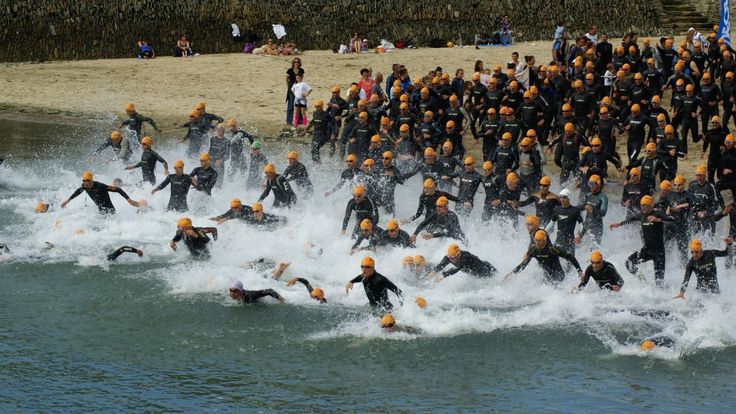Did you swim 100 meters in 1:12 as a kid? That’s great — but it’s not enough. Roughly 50% of your swimming skills will need to be rebuilt, and much of that will come from real race experience. These aren’t skills you can easily train in a pool. So what’s the issue? And why is it such a big deal? Let’s break it down.
Open Water Swimming
Triathlon swimming is, first and foremost, open water swimming. Forget pool lanes, crystal-clear water, perfect technique, and easy orientation using floor tiles, colored buoys, and the pool wall. You’ll need to learn how to swim in murky water, sight off other athletes’ feet or distant shoreline trees, chase blurry orange blobs on the horizon, and keep your cool as someone literally swims over you.
And yes, the sting of goggles pressed into your face after a heel kick from a breaststroker ahead will no longer surprise you. Triathlon swimming is chaos, stress, and constant unknowns.
Murk, Jellyfish & Other Creatures
- Murky water ruins visibility and triggers anxiety — and anxiety slows you down. It’s like walking through your kitchen at night, arms outstretched, unsure of every step.
- No pool markings means you’ll keep lifting your head to sight. That breaks rhythm, kills glide, and increases resistance.
- Without lanes or walls, you lose all sense of speed. It’ll feel like you’re going nowhere — prompting many to push too hard too early. That’s dangerous when you still have 750+ meters ahead.
- The start of every open water race is a contact sport. You’ll be hit, grabbed, swum over, and maybe even dunked — for the first 200–400 meters. For many, it feels like survival.
- Waves, sun glare, and saltwater force you to adjust your technique, breathing, and rhythm on the fly — switching between freestyle, backstroke, and even breaststroke.
- Nature adds its own surprises — weeds brushing your arms, jellyfish stings, ducks flying low, or even dolphins nearby. A jellyfish sting to the face? Not fun — but not fatal either.
Overcoming the Chaos
1. Murky Water
Visibility = direction. That’s why most triathletes use large swim goggles — not the sleek racing kind. Wider lenses give better awareness and calm your nerves. No, not a snorkeling mask — but almost.
2. Lack of Landmarks
From the shore, the buoys look obvious. But once you're in the water, surrounded by arms, splashes, and fogged-up goggles, they can vanish.
Best strategy: find big, visible landmarks on shore — buildings, powerline poles, mountain peaks. Swim at the venue the day before to spot them early. It’ll make race day way easier.
3. Losing Your Sense of Speed
In a pool, you use the wall to measure pace. In open water, learn to feel speed:
- Listen to how water flows past your ears.
- Sense resistance in your palms and feet.
- Notice how slowly large landmarks pass by.
- The more you practice outdoors, the more you’ll understand your natural pace.
4. Contact Sport at the Start
Rolling starts have helped reduce panic, but physical contact is still part of triathlon. Examples include:
- Someone swimming up your legs
- Getting tangled with a neighboring swimmer’s arms
- Catching a heel to the eye when someone switches to breaststroke
- A swimmer behind constantly touching your feet
- You don’t have to love it — but you should train for it. Practice with friends. And if you hate contact? Start wide and away from the main pack.
5. Weather & Conditions
Wind, waves, current, glare — they demand flexibility. You need a toolbox of skills:
- Breathing bilaterally
- Breathing every 2 or 3 strokes
- High-head freestyle
- Floating on your back
- Switching rhythm between strong core strokes and relaxed recovery
- The more options you have, the calmer you’ll stay.
6. Jellyfish
Ever been stung in the face by a jellyfish? It might cause temporary facial numbness. You’ll still be able to swim, bike, and run — but during the race, water might dribble out of one side of your mouth.
It stings like crazy, but trust us — you’ll laugh about it later.
Be Ready — And Try to Enjoy It
Train your skills, expect the unexpected, and meet the chaos with a calm mindset. Open water swimming isn’t just a test of fitness — it’s a mental game. And once you learn to play it well, it becomes one of the most exhilarating parts of triathlon.
Your OMY! Sports Team
